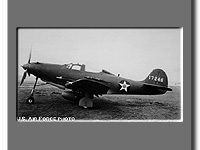
|
Description
| Manufacturer: | Bell |
| |
| Base model: | P-39 | ||
| Designation: | P-39 | ||
| Version: | F | ||
| Nickname: | Airacobra | ||
| Designation System: | U.S. Air Force | ||
| Designation Period: | 1925-1947 | ||
| Basic role: | Pursuit | ||
| Crew: | 1 | ||
| See Also: | P-45 | ||
Specifications
| Length: | 30' 2" | 9.1 m | |
| Wingspan: | 34' 0" | 10.3 m | |
| Gross Weight: | 7,500 lb | 3,401 kg | |
Propulsion
| No. of Engines: | 1 | ||
| Powerplant: | Allison V-1710-35 | ||
| Horsepower (each): | 1150 | ||
Performance
| Max Speed: | 368 mph | 592 km/h | 320 kt |
Known serial numbers
Recent comments by our visitors
| Kari Ebeling Espoo, YT | Please read the Saturday, September 13, 2008 issue of the Helsingin Sanomat, (side A16). It is the largest daily in Finland. It tells about the reconstruction of the Bell P-39Q with Soviet colours. One plane wreckage was collected in South-Eastern Finland after an emergency landing during WWII, and another from northern Norway. Other pieces were collected from Karelian isthmus from Aeracobras shot down during WWII by the Finnish fighters (Brewster) 09/13/2008 @ 03:52 [ref: 22676] |
| Guy E. Franklin Deastville, AL | The Bell P-39 Airacobra was one of the principal fighter aircraft in service with American forces at the start of World War II. (The P-39 was at first for a short time designated XP-45.)
The aircraft's unusual design featured its Allison engine mounted in the middle of the fuselage, just behind the pilot, driving the propeller through a driveshaft passing between the pilot's feet. The purpose of this was to free up space for the heavy main armament, a 37 mm T9 cannon firing through the center of the propeller hub for optimum accuracy and stability when firing. The weight distribution necessitated a tricycle undercarriage, a first among American fighters. Entry to the cockpit was through a side door rather than a moving canopy. The weight distribution of the P-39 supposedly is the reason for its tendency to enter a dangerous flat spin — a characteristic Soviet tests proved to the then-skeptical manufacturer who had been unable to reproduce them. The P-39's Allison V-1710 engine had a single-speed, single-stage supercharger, which brought about a decrease of performance compared to the promising prototype which had been fitted with an exhaust-driven turbo-supercharger. Due to the high weight of the P-39 and the poor high-altitude power of the mechanically supercharged Allison, the P-39's performance was markedly inferior to the contemporary European fighters, and as a result the first USAAF fighter units in the European Theater were equipped with the Spitfire V (which ironically featured a single-speed, single-stage supercharger, too). Above the V-1710's full throttle height of about 17,000 ft (5,000 m), the P-39's performance dropped off rapidly. This limited its usefulness in traditional fighter missions, in Europe as well as in the Pacific where it was not uncommon for Japanese bombers to attack at altitudes above the P-39's operational ceiling (which in the tropical hot air inevitably was lower than in moderate climates). It is mistakenly believed that the Airacobra was used as a ground-attack airplane by the Soviet Union; the lack of a turbo-supercharger restricting it to low-altitude combat. In fact, it appears that the Soviets did not use it for ground-attack, but instead to provide top cover. The tactical environment of the Eastern Front did not demand the high-altitude operations that the RAF and USAAF used with their big bombers. In the relatively low-altitude operations in the East the lack of a turbocharger was not as bad a handicap. The second-highest scoring Allied ace, Pokryshkin, flew the P-39 from late 1942 until the end of the war; his unofficial score in the Airacobra stands at nearly 60 Luftwaffe aircraft. 09/29/2006 @ 09:57 [ref: 14330] |
Recent photos uploaded by our visitors








